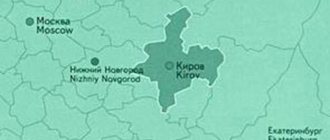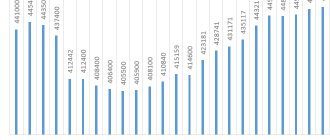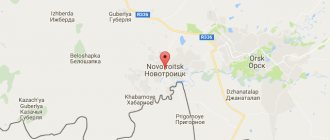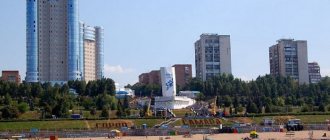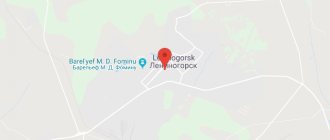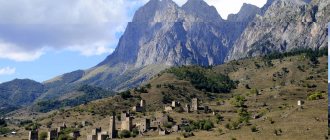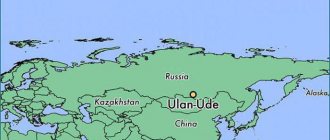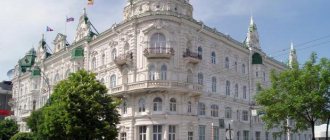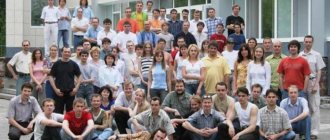Current data
Today 1,257,391 people live here. Compared to this year, the figure has increased due to visiting guests from other regions and regions of Russia. Among the statistical data, Kazan took first place in terms of population among the regions and republics of Nizhny Novgorod.
According to Rosstat statistics, the capital is considered the most populated among the Russian republics. In 2022, the population statistics are 125,969, of which 55% are women, 45% are men, and the average age is 39%. Below working age – 20%, above working age – 24%, working age – 56%. In terms of the number of residents, the facility ranks second in the TOP 10 cities in the country. The influx of residents comes from neighboring regions of Russia.
Population dynamics[ | ]
| Population | ||||||
| 1557 | 1800[4] | 1811[5] | 1840[5] | 1856[5] | 1858 | 1863[5] |
| 7000 | ↗40 000 | ↗53 900 | ↘41 300 | ↗56 300 | ↗61 000 | ↗63 100 |
| 1897[6] | 1907 | 1914[5] | 1917 | 1920 | 1923[5] | 1926[6] |
| ↗130 000 | ↗161 000 | ↗194 200 | ↗206 562 | ↘146 495 | ↗157 600 | ↗179 000 |
| 1931[7] | 1933[8] | 1939[9] | 1956[10] | 1959[11] | 1962[5] | 1964 |
| ↗200 900 | ↗258 700 | ↗398 014 | ↗565 000 | ↗646 806 | ↗711 000 | ↗742 000 |
| 1966 | 1967[5] | 1970[12] | 1973[5] | 1975[13] | 1976[14] | 1979[15] |
| ↗804 000 | ↗821 000 | ↗868 537 | ↗919 000 | ↗959 000 | →959 000 | ↗992 675 |
| 1982[5] | 1985[16] | 1986[14] | 1987[17] | 1989[18] | 1990[19] | 1991[14] |
| ↗1 023 000 | ↗1 051 000 | ↗1 060 000 | ↗1 068 000 | ↗1 094 378 | ↘1 094 000 | ↗1 105 000 |
| 1992[14] | 1993[14] | 1994[14] | 1995[16] | 1996[16] | 1997[20] | 1998[16] |
| ↘1 104 000 | ↘1 098 000 | ↘1 092 000 | ↘1 076 000 | →1 076 000 | ↗1 085 000 | ↘1 078 000 |
| 1999[21] | 2000[22] | 2001[16] | 2002[23] | 2003[5] | 2004[24] | 2005[25] |
| ↗1 100 800 | ↗1 101 000 | ↘1 090 200 | ↗1 105 289 | ↗1 105 300 | ↗1 106 900 | ↗1 110 000 |
| 2006[26] | 2007[27] | 2008[28] | 2009[29] | 2010[30] | 2011[31] | 2012[32] |
| ↗1 112 700 | ↗1 116 000 | ↗1 120 238 | ↗1 130 717 | ↗1 143 535 | ↗1 145 424 | ↗1 161 308 |
| 2013[33] | 2014[34] | 2015[35] | 2016[36] | 2017[37] | 2018[38] | 2019[39] |
| ↗1 176 187 | ↗1 190 850 | ↗1 205 651 | ↗1 216 965 | ↗1 231 878 | ↗1 243 500 | ↗1 251 969 |
| 2020[40] | 2021[2] | |||||
| ↗1 257 391 | ↘1 257 341 | |||||
Statistics by year
It is worth noting that the intraregional annual population growth in 2016 was -2418 people, in 2022 – 1683 people, in 2022 – 1219 people. The mortality rate is increasing every year, and the birth rate is decreasing. The growth rate over 1 year increased by 20.1 thousand or 0.68%.
The birth rate in the Republic is becoming lower every year. In 2019, the births of 19,684 children were registered, of which 99,098 were girls and 10,194 boys. This figure is very different from 2015, since 24,063 children were registered in that period; in 2016, 24,564 people were born; in 2022, 21,888 people were born. Demographic statistics indicate a decline in the birth rate throughout the country, not only in the republic.
Transport system
The city's transport system pleases others with its modernization. Kazan has an international airport, two railway stations, a river port, bus terminals and bus stations.
Local residents are satisfied with the condition of their city and its development. They prefer to travel by public or private transport. The authorities are making every effort to ensure that the population is provided for materially and spiritually. Therefore, it is not a problem for anyone to purchase a personal mode of transport, but some still prefer public transport, citing the fact that it is more economical.
In 2005, the Kazan metro was opened, which became a real holiday for all local residents. An interesting idea of the government and transport providers themselves was the invention of electronic smart cards. They are divided into general civil and preferential. They can make life easier not only for the conductor, but also for the passenger himself.
About the city
Kazan is a millionaire, the capital of Tatarstan. The oldest among Russian settlements. The capital is located on the left bank of the large, deep Volga River. To get to Kazan you can use air transport, ship or land transport. Since the capital is the center of trade and market relations between the regions of the country, it is also considered a huge transport and logistics hub of Russia. River routes and federal roads lead to the capital of Tatarstan. Large train stations and airports operate daily 24/7.
The environmental situation is in a sad state, as transport logistics are highly developed. Artificial reservoirs and natural rivers (Volga) are heavily polluted. Therefore, before supplying water to pipelines, the wastewater undergoes thorough treatment. High concentrations of hazardous chemicals were found in reservoirs: phosphorus, sulfates, nitrates. In the north of the capital of Tatarstan there are many industrial plants that daily discharge toxic chemicals into the environment. There is little vegetation growing in Kazan; it is rare to see the beautiful bright color of green grass.
Industry of Kazan
(Kazan synthetic rubber plant)
Kazan is a major industrial center of Russia.
The most popular areas of activity are:
- Mechanical engineering;
- Food industry;
- Light industry;
- Petrochemical industry.
(Kazan Powder Plant)
The largest enterprises are:
- Chemical complex Kazanorgsintez;
- Gunpowder factory
- as well as aircraft, engine and helicopter manufacturing plants.
National composition
Kazan is a multinational city, like all regions of Russia. The majority of the population is Russian and Tatar. A small share includes Armenians, Jews, Ossetians, Chuvashs - 0.8%, Ukrainians - 0.4%, Chinese - 0.3%, Germans - 0.09%, Ossetians - 0.3%, Russians -48.5 %, Tatars - 47.4%. The multi-ethnic density of the capital does not hinder development and transformation. There are many educational institutions, both higher and secondary, located in the capital. More than 115 nationalities live here.
Gender and age
In the capital, the number of women predominates several times. According to demographic data, the number of the male half is 10 times less and is equal to 44.6%, the female half is 55.4%. It’s easy to summarize: there are 10 times fewer living men than women. Another situation: for every 1000 men, there are 1241 women. There are about 300,000 children in the republic. Total number of people of disabled age. Most of the population is young compared to other populated areas of the Russian Federation. The average life expectancy for men is 67 years, for women – 71 years.
Marriages and divorces
For 15 years, there has been an increase in the number of marriages, by several tens of percent; for example, in 2016, 4,732 couples got married. More than 4,821 divorces were registered in the registry office.
The number of marriages increases every year, the number of divorces does not decrease; due to many reasons and negative factors affecting them, young married couples get divorced. Divorces often occur due to the inconsistency of the characters of young people, bad manners and laziness to work. Strong families with 3-5 children feel comfortable due to the presence of a well-developed infrastructure.
Migration
The birth rate far exceeds the number of immigrated citizens. Last year, 2022, there was a minimal jump in immigration, amounting to only 3,600 people. Over 9 years is considered the minimum figure. The flow of migrants has stopped.
Foreigners who received citizenship came from the countries: Ayzerbanzhan, Yerevan, Kalmykia, Spain, Italy. There are very few citizens who left their homeland; there are a large number of families who received maternity capital, which indicates a high standard of living. There was a time when the number of migrants exceeded the number of births; fortunately, everything has changed now.
Data for the Republic of Tatarstan
Forecast
Based on demographic and statistical data, it can be assumed that the capital will remain at a high level for 10 years or more. The multi-million population lives in comfortable, average conditions. Many strong families have 2-7 children, use maternal capital, the birth rate falls slightly every year, and the number of deaths increases.
In this situation, it should be assumed that in the next year the object will take sixth or seventh place in the list of TOP 10 cities. The level of migrants is low, so there is no reason to expect ethnic unrest. Environmental safety is in a deplorable state, since the level of emissions from industrial plants exceeds permissible standards several hundred times. Because of this, the growth of cancer and cardiovascular diseases has increased.
The level of education is high. There are 17 universities and more than 20 colleges and schools registered here. Medicine is well developed, help can be received in a timely manner and without waiting in line.
Job
Finding a job is very easy even for an economist. A large list of organizations will not leave the younger generation without work and money. Every year, new design works for factories and enterprises are created here, where the younger generation of professionals will work in the future.
Kazan is a large industrial city, where new educational institutions, residential and industrial facilities are constantly being built. Foreign citizens are involved in the work, one tenth of whom remain to live forever.
Story
Khan period
Having been founded as a northwestern outpost of the Bulgars, Kazan for a long time did not play a significant role in the life of Volga Bulgaria, and therefore it is impossible to estimate the population of the city with any accuracy. The first estimates of the population of Kazan date back to the era of the Kazan Khanate: by the middle of the 16th century, from ≈25,000[35] to 100,000[36] people, mostly Tatars by nationality, lived in the city. The subsequent capture of the city in 1552 was accompanied by complete ruin and depopulation, the population of Kazan fell many times, while the national composition of the city also changed dramatically - it became predominantly Russian.
Imperial period
According to the general census of 1738, 192,422 people lived in Kazan,[37] which is more than in any other city of the Empire. However, although such statements are found in some sources, it is incorrect to call Kazan the largest city in Russia at that time, since in the general census the population of the city was taken into account with a county with an area of about 5 thousand km², which also included numerous peasants from the district villages and hamlets . With some stretch, it can be said in modern terms that in the middle of the 18th century, Kazan had the most populated metropolitan area (complete urban agglomeration) in the Russian Empire.
In 1907, 81.7% of Kazan residents were Russian[38].
Soviet period
The revolution and the subsequent Civil War are associated with a noticeable demographic failure - in 3 years the population decreases by more than a quarter.
Subsequently, throughout the Soviet period of history, Kazan experienced significant growth. In the pre-war years of intensive industrialization, sharp growth was associated with the creation of new industrial sites in the riverine and eastern parts of the city and the command-administrative attraction of labor for their construction and subsequent work in new plants and factories. The city's population doubled.
During the Great Patriotic War, Kazan received a significant number of large factories and all-Union scientific organizations evacuated from the western and northwestern parts of the country, along with a large number of civilians. The city's population almost doubled, and after the war, a significant part of the evacuees settled in Kazan, increasing its total population by almost one and a half times.
In the following decades, the city's major growth continued due to urbanization. Due to the fact that in the rural areas of the TASSR, where the bulk of migration to the city came from, Tatars predominated, the shares of the Russian and Tatar populations leveled off, first to parity values, and by the end of the Soviet period the Tatar share began to predominate and further increase.
The millionth resident of the city was born in 1979[39]. Contrary to the prevailing belief of even some Kazan residents, this was not achieved artificially through the annexation of the large exclave villages of Yudino and Derbyshki, which became parts of the city long (four decades) before.
Modern period
Depopulation observed since the early 1990s. in almost all Russian cities, including millionaires, did not appear in Kazan, and the city continued to grow. In the list of Russian cities by population, the city rose from 10th to 6th place. Although the birth rate continued to remain lower than the death rate until 2009 (when natural population growth was recorded [40]), the resulting increase in the city’s population was associated with the migration influx and the inclusion of new settlements within the city. At the same time, the population of the annexed territories was about 20 thousand people (about 14 thousand in 14 villages in 1998, about 2 thousand in 2 villages in 2001, about 4 thousand in 5 villages in 2008), and the population growth of the city amounted to 52 thousand people. A larger (by another 30 thousand people) increase in the city’s population due to what was proposed and defended in 2003-2004. The administration of the mayor of Kazan Iskhakov did not increase the territory of the city by annexing Vasilyevo and the surrounding area due to the fact that these plans met with opposition from the district authorities and were not supported by the republican leadership.
According to the master plan for the development of the city, in force since 2007, due to some further annexation of new territories to the city and the development of them and previously annexed lands through the construction of new blocks of mass multi-storey residential development and settlements of individual cottage construction, it is planned to increase the population of the city to 1 million 123 thousand in 2010, 1 million 180 thousand in 2022 and 1 million 500 thousand in 2050. In 2010, the planned indicators were exceeded - the city’s population amounted to 1 million 139 thousand.
In addition, the already partially implemented and planned further virtually unbroken expansion of Kazan in the western direction (Zalesny - Orekhovka - Vasilyevo), including the construction of a 100,000-person “bedroom” multi-story satellite city “Salavat Kupere” starting in 2012 under the socio-economic program after Zalesny and The planned creation by the republican authorities between Vasilyevo and Zelenodolsk of another satellite city “Green Dol” for 157 thousand people[41], make it possible in the future to join Kazan from its agglomeration not only of Orekhovka, Vasilyevo, but also of these cities- satellites and Zelenodolsk with a population of 100 thousand.
